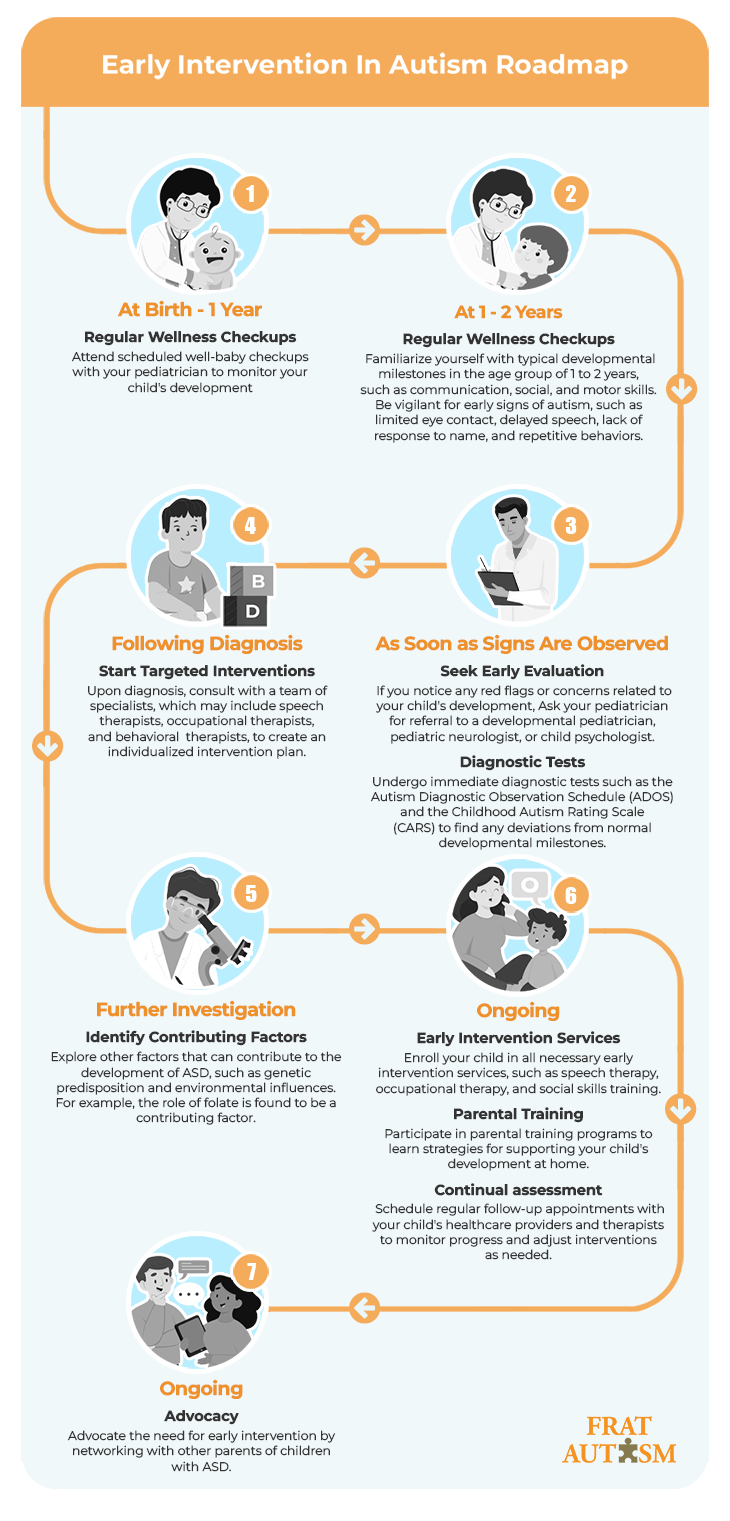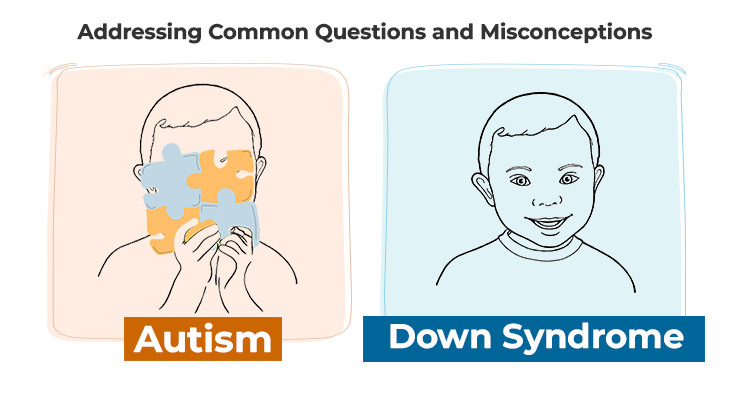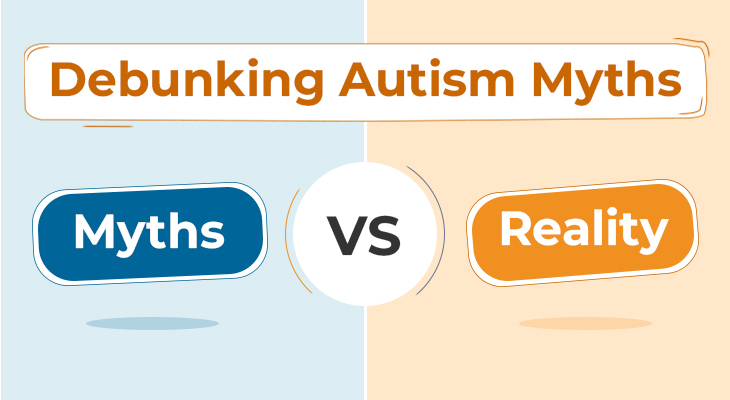Table of Content
- Understanding the positive, long-term effects of early intervention
- Early intervention in Autism – All You need to know
- Autism & Folate – Understanding their connection
- Empower others – Share what you know with others
- Conclusion
- Did You Know About Folate Receptor Autoantibodies (FRAAs) and Brain Development?
- References
Starting Strong: Unveiling the Positive Impact of FRAT® and other Early Autism Interventions
Autism spectrum disorder (ASD) is on the rise across the US, a fact acknowledged by experts. While the precise factors fueling this increase are not definitively understood, several theories have been put forth. These include heightened awareness leading to more accurate diagnoses, advancements in diagnostic tools, genetic variations, and potential environmental triggers. Regardless of the drivers, a growing body of evidence supports the value of early diagnosis and treatment with evidence-based interventions, which can significantly improve the quality of life of individuals with ASD as well as of their caregivers and families. In this blog, we’ll delve deeper into the need for and benefits of early intervention in children with autism.
Early Intervention in Autism can make a real difference! Really, we mean it!
According to a study by National Institute of Child Health and Human Development (NICHD), certain children with autism, when provided with timely intervention, exhibit remarkable advancement to the extent that they no longer fall within the autism spectrum as they grow older. In the heart of this research lies a glimmer of hope, showing that early intervention holds the key to unlocking remarkable progress in some children with autism, reshaping their trajectory.
In a 5 year study conducted by the university of Washington analyzing the benefits of ABA based interventions, it was found that fewer than 10% of non-verbal children remained non-verbal when following an early intervention program. The study also found that children who are completely non-verbal who begin intervention in the early preschool years are far more likely to become verbal than children who begin intervention over the age of 5. This result underscores the remarkable potential for positive change through timely interventions.
Early intervention programs for autism can be very effective. Studies have shown that children who receive early intervention are more likely to develop communication and social skills, and they are less likely to have challenging behaviors. Early intervention can also help children with autism reach their full academic potential.

Download Download & share this infograph in your network [Free Download]
Early Intervention in Autism - Here’s all you want to know
In relation to Autism Spectrum Disorder (ASD), early intervention encompasses a proactive and thorough strategy, seeking to deliver precise assistance and therapies to young children with autism, ideally prior to reaching three years of age.
Autism is something doctors can find in children before they turn 2, and some children who were developing normally might start displaying autism related problems around the age 2. When they’re this young, toddlers can benefit more from early interventions than at later ages.
Getting help early doesn’t just help kids start strong, it also gives them the best chance to learn and grow. Experts now say that as soon as autism is noticed, kids should start getting help right away.
What is the science behind early intervention?
We all know that children’s brains are highly amenable to change and growth. The science behind early intervention is grounded in the fact that during this time, a young child’s brain is still forming, making it more flexible and changeable compared to when you’re older; this is called neuroplasticity. Because of this flexibility, scientifically called neuroplasticity, treatments have a better chance of working for a long time.
What are the goals of early intervention?
Singly or in combination, all early interventions have the same goals – early identification of ASD, reducing symptom severity, providing essential family support and education, and better developmental outcomes. Early intervention programs help children gain the basic skills that they usually learn in the first 2 years of life, such as:
- Physical skills
- Thinking skills
- Communication skills
- Social skills
- Emotional skills
What do early intervention programs include & what are their benefits?
They can be delivered in a variety of settings, including home, school, and community-based programs. Early intervention programs for autism typically focus on the following areas:
Communication Enhancement
Assisting children in cultivating communication abilities encompassing speech, sign language, and systems like picture exchange communication.
Social Proficiency
Guiding children in acquiring interaction aptitudes, fostering friendships, and engaging in collaborative play.
Behavioral Guidance
Supporting children in effectively managing their emotions and conduct through positive approaches.
Sensory Integration
Aiding children with autism in processing sensory information more effectively, allowing them to better comprehend their surroundings.
Academic Development
Facilitating the learning of fundamental academic skills such as reading, writing, and mathematics for children with autism.
What are some of the early intervention programs?
There are several early interventions possible, based on the child’s needs and the goals of the program. Some of them are:
Applied Behavior Analysis (ABA)
This is a data-driven and systematic approach that focuses on analyzing and modifying behaviors by breaking them down into smaller, manageable components.
Speech Therapy
Targets communication challenges by assessing and addressing language difficulties, articulation, and nonverbal communication.
Occupational Therapy (OT)
Focuses on enhancing a child’s fine motor skills, sensory processing abilities, and daily living skills.
Developmental and Relationship-Based Approaches (DIR)
Emphasizes the importance of social-emotional development and forming meaningful relationships.
Early Start Denver Model (ESDM)
Is a play-based intervention that blends developmental and behavioral principles.
Floortime
Also known as Developmental, Individual-Difference, Relationship-Based (DIR/Floortime), involves therapists joining children on the floor and following their lead in play and exploration.
Picture Exchange Communication System (PECS)
Is a visual communication system that uses pictures or symbols to help nonverbal or minimally verbal individuals communicate their needs and desires.
Social Skills Groups
Provide a structured and supportive environment for children with autism to learn and practice social interactions.
Sensory Integration Therapy
Involves activities that help children with autism process sensory information effectively.
TEACCH (Treatment and Education of Autistic and Communication-related Handicapped Children)
Is an educational and behavioral intervention that focuses on structuring the environment to support individuals with autism by utilizing visual schedules, visual supports, and individualized workstations to enhance learning and independence.
Empower others - Share what you know with others
Empower parents and caregivers in your network by sharing the knowledge you have gained in this blog. Here are a few things you can do:
Advocate
Advocate for early intervention by sharing the The Early Intervention Roadmap Infographic with other parents, friends & family
Spread
Spread the knowledge and sensitize others by sharing this blog with teachers & school management. Click on the share icon to this now
Retweet
Click on the tweet icon to send a message to your followers on Twitter. Request them to retweet it.
Conclusion
In the journey of early detection and intervention in Autism Spectrum Disorder (ASD), parents undoubtedly play a pivotal role. The notion that “early intervention is key” couldn’t ring truer. Remember:
- When it comes to interventions, earlier the better
- Timely early interventions could potentially help autistic children outgrow the symptoms and issues associated with the condition
- Follow the early intervention roadmap so you don’t miss any step
For information on autism monitoring, screening and testing please read our blog.
References
- Applied Behavior Analysis (ABA): National Autism Center: www.nationalautismcenter.org
Association for Behavior Analysis International: www.abainternational.org - Speech Therapy: American Speech-Language-Hearing Association (ASHA): www.asha.org
National Institute on Deafness and Other Communication Disorders (NIDCD): www.nidcd.nih.gov - Occupational Therapy (OT): American Occupational Therapy Association (AOTA): www.aota.org; World Federation of Occupational Therapists (WFOT): www.wfot.org
- Developmental and Relationship-Based Approaches (DIR): Interdisciplinary Council on Development and Learning (ICDL): www.icdl.com; Profectum Foundation: www.profectum.org
- Early Start Denver Model (ESDM): UC Davis MIND Institute: health.ucdavis.edu/mindinstitute
- Floortime: The Floortime Center: www.floortime.org
- Picture Exchange Communication System (PECS): Pyramid Educational Consultants: www.pecsusa.com
- Social Skills Groups: Social Thinking: www.socialthinking.com; The National Professional Development Center on Autism Spectrum Disorders: www.autismpdc.fpg.unc.edu
- Sensory Integration Therapy: STAR Institute for Sensory Processing Disorder: www.spdstar.org
- TEACCH (Treatment and Education of Autistic and Communication-related Handicapped Children): TEACCH Autism Program: teacch.com
- National Research Council, Committee on Educational Interventions for Children with Autism. (2001). Educating Children With Autism. Lord, C., McGee, J. P., eds. Washington, DC: National Academies Press.
- Olley, J. G. (2005). Curriculum and classroom structure. In: Volkmar, F. R., Paul, R., Klin, A., Cohen, D. (Eds.), Handbook of Autism and Pervasive Developmental Disorders. 3rd ed. Vol II (863–881). Hoboken, NJ: John Wiley & Sons.
- Helt, M., Kelley, E., Kinsbourne, M., Pandey, J., Boorstein, H., Herbert, M., et al. (2008). Can children with autism recover? If so, how? Neuropsychology Review, 18(4), 339–366.
- Rogers, S. J., & Lewis, H. (1989). An effective day treatment model for young children with pervasive developmental disorders. Journal of the American Academy of Child and Adolescent Psychiatry, 28(2), 207–214.
- Reichow, B., & Wolery, M. (2009). Comprehensive synthesis of early intensive behavioral interventions for young children with autism based on the UCLA young autism project model. Journal of Autism and Developmental Disorders, 39(1), 23–41.
- Zwaigenbaum, L., Bauman, M. L., Choueiri, R., Kasari, C., Carter, A., Granpeesheh, D., et al. (2015). Early intervention for children with autism spectrum disorder under 3 years of age: Recommendations for practice and research. Pediatrics, 136(Suppl 1), S60–81.
- Dawson, G., Rogers, S., Munson, J., Smith, M., Winter, J., Greenson, J., et al. (2010). Randomized, controlled trial of an intervention for toddlers with autism: the Early Start Denver Model. Pediatrics, 125(1), e17–23.
- Dawson, G., Jones, E. J. H., Merkle, K., Venema, K., Lowy, R., Faja, S., … & Webb, S. J. (2012). Early behavioral intervention is associated with normalized brain activity in young children with autism. Journal of the American Academy of Child & Adolescent Psychiatry, 51(11), 1150-1159.
- Eldevik, S., Hastings, R. P., Hughes, J. C., Jahr, E., Eikeseth, S., & Cross, S. (2009). Meta-analysis of early intensive behavioral intervention for children with autism. Journal of Autism and Developmental Disorders, 39(10), 1540-1552.
https://www.researchgate.net/publication/24422642_Meta-Analysis_of_Early_Intensive_Behavioral_Intervention_for_Children_With_Autism - Frye, R., Slattery, J., Delhey, L. et al. Folinic acid improves verbal communication in children with autism and language impairment: a randomized double-blind placebo-controlled trial. Mol Psychiatry 23, 247–256 (2018). https://doi.org/10.1038/mp.2016.168
- McEachin, J. J., Smith, T., & Lovaas, O. I. (1993). Long-term outcome for children with autism who received early intensive behavioral treatment. American Journal of Mental Retardation, 97(4), 359-372.




